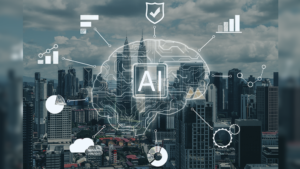By Grant Price, CEO, Yoho Workplace Strategy
Artificial intelligence looks set to be the most disruptive force in the way we service and engage with our customers and each other of 2024, with the promise of many benefits as well as challenges.
For our digital marketing and media industries the change to ways of working promise to be rapid and dramatic. Those who refuse to join the AI revolution will be left behind and risk losing competitive advantage. However, those who decide to embrace AI should ensure that maintaining human connections remains at the heart of any AI strategy and use policy, as they navigate their way through uncharted territory.
Throughout history, humans have thrived as a species by connecting with others, whether they were hunting and gathering, collaborating on scientific discovery or spending time together enjoying social and sporting activities. Human connection has been essential to our survival and progress.
Face to face connection helps boost mood, manage emotions and improve general wellbeing. It helps us to feel loved, cared for and valued and forms the basis for our interpersonal relationships and emotional wellbeing.
According to Maslow’s hierarchy of needs, connecting with others is as fundamental as the need for food and water. From mice to mankind, animals and people suffer whenever social bonds are threatened or severed.
Digital media and marketing businesses need to take note, because the connections which are so critical to our health, our ability to be productive in our work and to connect with audiences, is under greater threat than ever before.
The age of AI
We are already increasingly starved of human connections by the increase in virtual interactions and reliance on digital communication, which has led to a reduction in seeing people face to face.
The demands of modern-day life with endless meetings, school activities, family responsibilities and the need to balance home and work commitments, leave little time for meaningful human connection.
It could be argued that the pervasive use of smartphones and social media has created a false sense of constant connection, while contributing to a lack of genuine human interaction, giving us even less time to build and sustain meaningful relationships.
Just last year a study published in the journal Nature Human Behaviour found that social isolation increased the risk of early death by 32% and loneliness increased the risk of death by 14%.
As we hurtle into the age of artificial intelligence, we will rely more on AI for social interactions and the amount of human contact will be reduced, further fostering feelings of alienation and isolation from friends, family and colleagues.
AI is already creating conversations that are devoid of emotion, making it difficult for people to form meaningful relationships or understand how others in our social and work circles are truly feeling. Most concerning is that the pervasive use of AI will inhibit deep human connections, leaving relationships with others less reciprocal, shallower or more narcissistic. This threatens to stunt emotions and further inhibit genuine human connection.
Staying human
Business leaders need to acknowledge and understand how serious that loss of human connection will be and collectively make a conscious decision to act. A lack of intervention to prevent continued erosion of our ability to connect is a tangible, existential threat to our way of life and potentially even to our very survival.
There are many questions businesses should ask before setting their AI strategy and use policy, such as what problems AI could potentially help them to solve and how AI could free up employees to focus on higher impact tasks, which improve efficiency and company prospects.
Leaders should also consider how they will maintain the quality, security and modernity of AI systems before actioning their integration. It’s also important to implement governance policies which cover the use of AI and map out how progress will be benchmarked and tracked, and achievements measured.
Senior executives should take time to understand the capabilities of GenAI and assess the risks and rewards of introducing this evolving technology. Think about what new AI powered products or services could be delivered and plan to stay up-to-date with governance legislation and ensure access to legal counsel for guidance.
These are not an exhaustive list of questions to ask before setting the AI strategy and use policy and there may well be more.
The next step is to create a robust AI strategy, use policy and action plan, but to remember that humans instinctively engage more easily with content created by other humans. It’s essential we take a more human centric approach now that AI will be part of our everyday lives and the way we work.
Businesses which invest a little time and effort to create a considered AI strategy and use policy, which put people at the core, will reap the rewards of much lower risk and significantly higher commercial returns than those who dive in headfirst.
Digital media and marketing businesses will doubtless be overwhelmed with new AI tools which promise to generate adverts and create content, and much more.
However, marketers will need to learn how to use AI to leverage its benefits while navigating around an evolving array of uncertainties and risks, and they will need to ensure they stay up to date with the developments in AI tech as they continue to iterate at breakneck speed.










